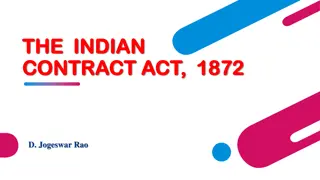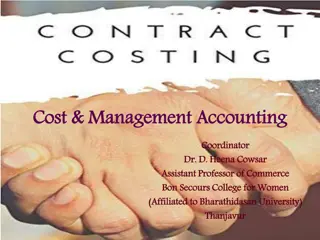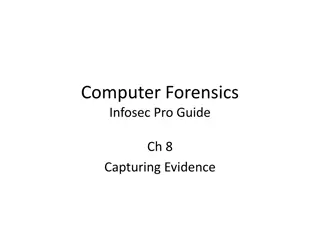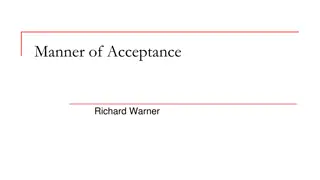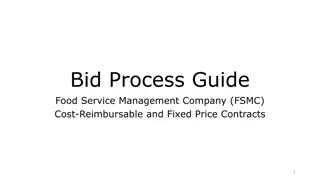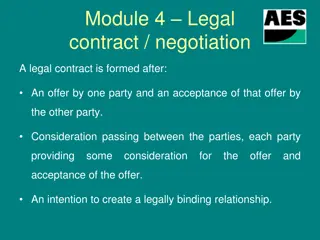Verifying the Acceptance of a Contract - Principles of Acceptance
This document delves into the essential principles surrounding the acceptance of a contract, emphasizing the necessity of external manifestations of assent for the creation of a binding agreement. It covers various forms of acceptance, clarifying that silence alone does not constitute acceptance and highlighting key acceptance principles that dictate the communication requirements between offeror and offeree.
Download Presentation

Please find below an Image/Link to download the presentation.
The content on the website is provided AS IS for your information and personal use only. It may not be sold, licensed, or shared on other websites without obtaining consent from the author.If you encounter any issues during the download, it is possible that the publisher has removed the file from their server.
You are allowed to download the files provided on this website for personal or commercial use, subject to the condition that they are used lawfully. All files are the property of their respective owners.
The content on the website is provided AS IS for your information and personal use only. It may not be sold, licensed, or shared on other websites without obtaining consent from the author.
E N D
Presentation Transcript
Do we Have a Deal? Verifying the Acceptance of a Contract Peter Moran Principal Norton Gledhill
Overview Principles of Acceptance Law of Signatures Electronic Signatures definition Electronic Signatures some cases Electronic Acceptances issues for the future Tips for Practitioners Do We Have a Deal? | 16 March 2016 Page3
Acceptance For an offer to be accepted such that it constitutes a binding agreement: There must be an external manifestation of assent, some word spoken or act done by the offeree or by his or her authorised agent that the law can regard as the communication of the acceptance to the offeror. Powell v Lee (1908) 99 LT 284 Do We Have a Deal? | 16 March 2016 Page4
Forms of Acceptance There must be some form of communication of intent to accept the offer, ie: Affixing a signature or mark to written terms. Verbal acceptance. Conduct such as the offeree performing obligations (unilateral contract). Implied by the circumstances eg postal acceptance. Do We Have a Deal? | 16 March 2016 | Page5
Forms of acceptance Silence cannot amount to acceptance (Felthouse v Bindley) but: silence and conduct can because the element of communication of intent can still be present; requirement to communicate acceptance can be waived - eg automatic renewals - see Nortel Australia Pty Ltd v Portfolio Leasing Australia Ltd (1998) 8 BPR 15, 857; and offeror cannot prescribe silence as a method of acceptance and then use the failure to communicate acceptance as a basis to avoid the contract. Do We Have a Deal? | 16 March 2016 Page6
Acceptance principles The offeror must merely know of the acceptance, even though the acceptance was not brought to the offeror s notice by the offeree. Brambles Holdings Ltd v Bathurst CC (2001) 53 NSWLR 153 If the offeror has prescribed a form of acceptance, that form must generally be followed for acceptance to have occurred. Latec Finance Pty Ltd v Knight [1969] 2 NSWLR 79. The risk of non-communication of acceptance is on the accepting party. For Example, in Latec the service provider reversed the onus (ie made the customer the offeror) and, by not communicating its acceptance back to the customer, the customer was held not to be bound to the service provider even though they had filled out and submitted the requisite form. Do We Have a Deal? | 16 March 2016 Page7
Signatures Courts flexible approach A signature can: be a rubber stamp; Lazarus Estates, Ltd. v. Beasley [1956] 1 QB 702; London County Council v. Vitamins, Ltd., London County Council v. Agricultural Food Products, Ltd. [1955] 2 QB 218; Goodman v J Eban [1954] 1 QB 550 be initials, a cross or any mark that identifies the act of the person; (Morton v Copeland (1855) 16 CB 517; Baker v Dening (1838) 8 A&E 94; Hill v Hill [1947] Ch 231; Newall v Tarrant [2004] EWHC 772) be a name typed or printed into an agreement; Durrell v Evans (1862) H & C 174, Brydges v. Dix (1891) 7 TLR 215; France v. Dutton [1891] 2 Q.B. 208, Newborne v. Sensolid (Great Britain), Ltd. [1954] 1 QB 45, Neill v Hewens (1953) 89 CLR 1, Torrac Investments Pty Ltd v Australian National Airline Commission (1985) ANZ ConvR 82 but cf Russell v Slater [1912] QSR 237 Do We Have a Deal? | 16 March 2016 | Page8
Signatures Courts flexible approach A signature can: appear at any part of the memorandum of terms not just at the beginning or end; and Heppingstone v Stewart (1910) 12 CLR 126 be applied by an agent. Newall v Tarrant [2004] EWHC 772 Do We Have a Deal? | 16 March 2016 Page9
Signatures Courts flexible approach Authenticated Signature Fiction Someone s name typed in a contract could be construed as their signature if the person so named recognize[d] the instrument containing his name as the final and complete expression of a contract he then or there entered into as a party this would satisfy Statue of Frauds requirement notwithstanding there wasn t signature in the traditional sense. Neill v Hewens (1953) 89 CLR 1 following a line of authorities such as Knight v Crockford (1794) 1 Esp 190 (170 ER 324); Saunderson v Jackson (1800) 2 Bos & Pul 238 (126 ER 1257); Schneider v Norris (1814) 2 M & S 286 (105 ER 388); Johnson v Dodgson (1837) 2 M & W 653 (150 ER 918); Durrell v Evans (1862) 1 H & C 174 (158 ER 848); Evans v Hoare (1892) 1 QB 593; Cohen v Roche (1927) 1 KB 169 and Leeman v Stocks (1951) Ch 941 Accepts but then finds a way around the form over function view of signatures Do We Have a Deal? | 16 March 2016 Page10
Signatures function over form A signature, as a legal concept, bears no relationship to the popular conception of a name, on paper, in the signatory s own handwriting. A signature is not a thing but a process. If that process produces sufficient evidence that a person has adopted a document as his own, and that document before the court is the same document to which the process was applied, then the document has been signed. Prof Reed C, What is a Signature , 2000(3) The Journal of Information, Law and Technology (JILT). Cf Firstpost Homes Ltd v Johnson [1995] 1 WLR 1567 - the term signature must be given its ordinary linguistic meaning such that the parties must write their names with their own hands upon the document. Do We Have a Deal? | 16 March 2016 | Page11
Electronic Signatures It makes no difference whether that operator writes the acceptance with a steel pen an inch long attached to an ordinary penholder, or whether his pen be a copper wire a thousand miles long. In either case the thought is communicated to the paper by the use of the finger resting upon the pen; nor does it make any difference that in one case common record ink is used, while in the other case a more subtle fluid, known as electricity, performs the same office. Howley v Whipple, 48 N.H. 487 (1869) Supreme Court of New Hampshire Do We Have a Deal? | 16 March 2016 Page12
Electronic Signatures Definition in Australia An electronic communication satisfies an obligation to provide a signature if: 1. a method is used to both identify the signee and indicate their intention; 2. the method is as reliable as is appropriate; and 3. the counterparty consents to the method used. Section 10 of Electronic Transactions Act 1999 (Cth) and section 9 of the Electronic Transactions (Victoria) Act 2000 (Vic) Which largely follows the approach suggested by the UN in the UNCITRAL Model Law Do We Have a Deal? | 16 March 2016 Page13
Electronic Signatures Definition in United States A signature is an electronic process logically associated with a record that is adopted by a person with the intent to sign that record. Section 206 of the Electronic Signatures in Global and National Commerce Act Section 1710 of the Government Paperwork Elimination Act Section 2 of the Uniform Electronic Transactions Act Title of presentation | 10 April 2015 | Page14
Electronic Signatures What does an electronic signing process need to contain to be valid? 1. The process must identify and authenticate a person. 2. It must indicate the person s approval of the terms. 3. The link between the signature and the contract must be of sufficient integrity. Do We Have a Deal? | 16 March 2016 Page15
Electronic Signatures Questions for practitioners to ask in determining if an electronic signing process is acceptable: 1. Can you prove that the approval is genuinely from the person asserting to have provided the electronic signature? 2. Was the signing method used by the accepting party agreed to by the offeror? 3. Is it clear that the person intended to approve the contract terms by virtue of completing the electronic signature process? 4. Is the signed document provided back to the offeror the same as that signed by the accepting party and initially provided by the offeror? Do We Have a Deal? | 16 March 2016 | Page16
Electronic Signatures some cases - Email J Pereira Fernandes SA v Mehta [2006] 2 All ER 891 Defendant sent an email with an offer of a guarantee. Defendant s name not included but email header contained defendant s email address which contained their name. Provided a person inserts their mark into a document with the intention of giving it authenticity, it does not matter if it s a full name; or a first name prefixed by some or all initials; or by using a pseudonym or a combination of letters and numbers. It makes no difference if a person does so in an electronic document or a hard copy. In this case, the automatic insertion of the email address in the header was too incidental to be evidence of the defendant s intention to give the email authenticity. However, in obita, Judge Pelling QC held that a person typing his or her name into an email, including via typing an email address, into an email could be a sufficient signature for the purpose of satisfying the Statute of Frauds. Do We Have a Deal? | 16 March 2016 Page17
Electronic Signatures some cases - Email Legal Services Board v Forster [2010] VSC 192 Legal Services Board circulated a resolution to appoint a receiver to a legal practice which was required to be signed by the members of the Board. One member sent an email with the resolution and stated: The signature is typed in as I am away at the moment and don t have access to a printer . Emerton J held that the typed signature was intended to stand as the person s signature. He referred to common law authorities, such as Morton v Copeland, that a signature may be any mark which identifies it as the act of the party. Emerton J also noted that the method used had been consented to by the entire Board and that, therefore, this form of signing was validated by section 9 of the Electronic Transactions (Victoria) Act 2000 (Vic). See also Harding v Brisbane City Council & Ors [2009] 196 QPELR 207. Title of presentation | 10 April 2015 | Page18
Electronic Signatures some cases clickwrap and browsewrap Bay International AG v Creative Writing Festival Entertainment Pty Ltd (2006) 170 FCR 450 Clicking on send this order and purchase ticket buttons on an online form (after having provided identification) was held to constitute the signing of an electronic contract. US decisions indicate that browsewrap agreements will be upheld if the user has actual or constructive knowledge of a website or app s terms and conditions prior to use. Every occasion that a clickwrap agreement has been considered by the courts in the US, they have been found to be enforceable. Fitzgerald, Fitzgerald, Middleton, Clark and Lim, Internet and E-Commerce Law, Business and Policy Lawbook Co, 2011 Do We Have a Deal? | 16 March 2016 | Page19
Electronic Signatures some cases other forms of e-signing Getup Ltd v Electoral Commissioner (2010) 189 FCR 165 The signing of an electronic document with a conventional signature but using a digital pen on a tablet is one of the few methods considered. The Federal Court held that this method satisfied a legislative requirement to provide a signed form. Justice Perram noted, as an aside, that whilst such a method of signing could be subject to abuse through forging or manipulation of the signature, he could not discern any greater risk in this situation than with forms provided via fax or email scans. Do We Have a Deal? | 16 March 2016 | Page20
Electronic Acceptance Issues for the Future Does the postal acceptance rule have a place in electronic contracts? - instantaneous communication or does it have parallels with letters email versus clickwrap. Could the last act rule become more significant than notions of signatures? Cheshire & Fifoots What will emerge as the mainstream form of electronic contracts (and replace email scans of hard copy contracts)? Docusign, Echosign Will digital signatures replace all signatures? eg biometrics versus password, pins, signatures. How will the law of contract deal with EDI and internet of things (law of agency)? Do We Have a Deal? | 16 March 2016 | Page21
Tips for Practitioners 1. Focus on function over form when advising upon acceptances of contractual offers (eg agreement via email can be OK). 2. If using an electronic method, ensure the method of acceptance is clearly agreed by parties (eg email agreement prior). 3. Ensure the method of acceptance identifies the parties accepting (eg personal versus group email receipt). 4. Ensure an acceptance is linked to a clear set of terms that can t be altered subsequently (eg pdf of whole document verses signing page only). Do We Have a Deal? | 16 March 2016 | Page22




